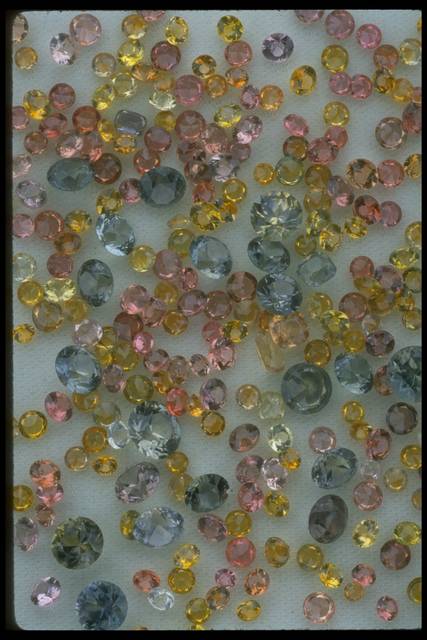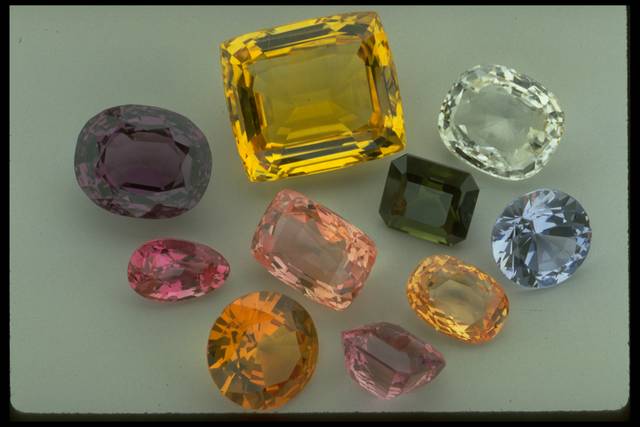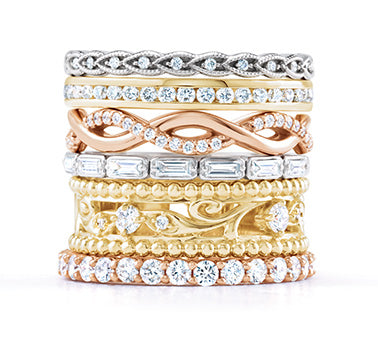Lifetime Warranty
24/7 Hour Customer Service
Free Shipping
30-Day Return
Moijey Fine Jewelry & Diamonds Blog
Fancy Sapphires: Need We Say More?
Originally posted on September 9th, 2017
Updated April 10th, 2020
People born in September can enjoy their birthstone in all the colors of the rainbow, aside from the traditional blue. Fancy sapphires (or fancies) are sapphires that occur in every color, except for blue and red, which is ruby. Fancies are lovely for people who enjoy the romance of owning a sapphire and the desire for something truly one of a kind. Here is the plethora of colors available for September babies from the Yogo Gulch Mines in Montana. Aren't they gorgeous?

Photo by Chip Clark. A closeup from the Smithsonian Gem and Mineral Collectors in 1961.
Corundum is traditionally colorless. For corundum to become fancy, certain combinations of the trace elements iron, titanium, and chromium need to enter corundum's aluminum oxide structure to produce all kinds of colors.
Red is merely ruby. A variety of the corundum species, but not a fancy sapphire. It is still a gem with its reputation and beauty. See our July articles for more details.
Like ruby, pink obtains its pretty color from chromium. The amount of chromium is very - I repeat, very - faint. Sometimes titanium will contribute to the pink also. The pear-shaped pink sapphire in our Bezel Bypass Pear Ring Mounting is a lovely example. Unfortunately, there is an ongoing debate about how much chromium should be in pink sapphire to identify as, well, pink sapphire. It used to be common practice to call pink sapphire "ruby. Thankfully, the standards are more specific for pink sapphire today, where the color is light in tone.





A beautiful and modern bypass ring
Orange and Yellow colors come from iron and possibly chromium color centers. Color centers are technically structural defects in a gem's atomic structure and impact its light absorption abilities. The yellow and orange colors can also be created through irradiation, which uses electromagnetic radiation or subatomic particles to change the color. Don't worry; the process is a lot safer than it sounds. Despite the safety and the results of deeper colors, the process is unstable and will fade in sunlight. Thankfully, the sapphires we provide at Moijey are durable in all kinds of light! These examples from the Smithsonian are show remarkable yellow and orange colors.


Isn't the tiny orange sapphire adorable?
Just recently, we had a client who chose a 14K White Round Halo Accented Engagement Ring Mounting with a round yellow sapphire in the center. He chose yellow sapphire because yellow is his girlfriend's (now fiancee's) favorite color.





The groom made an excellent choice with this setting and the yellow sapphire.
Green sapphires are readily available, but usually in an olive or khaki color. Green comes from a combination of iron - which makes yellow - and titanium with iron - which produces blue. The elements go through an intervalence charge transfer.


http://www.webexhibits.org/ causesofcolor/8.html
causesofcolor/8.html
 What's that? Good question. An intervalence charge transfer is where two impurity atoms get separated by another atom and can still exchange electrons for absorbing light selectively. Atoms from the trace elements bounce back and forth to each other, almost like a game of catch. Despite the accessible and the mentioned unappealing colors, there are still gorgeous green colors! Behold, this luscious lime green sapphire from the Smithsonian! Look at it! Revel in the springiness of this gem!
What's that? Good question. An intervalence charge transfer is where two impurity atoms get separated by another atom and can still exchange electrons for absorbing light selectively. Atoms from the trace elements bounce back and forth to each other, almost like a game of catch. Despite the accessible and the mentioned unappealing colors, there are still gorgeous green colors! Behold, this luscious lime green sapphire from the Smithsonian! Look at it! Revel in the springiness of this gem!

Photo by Ken Larsen. A gorgeous green specimen!
Purple sapphires (did you notice that I almost followed the order of the rainbow? Almost) are similar to the pink sapphires with chromium. Only they're darker in tone. It ranges from reddish purple to violetish purple. Varying combinations of iron, titanium, and chromium cause purple, its sometimes called amethystine sapphire because of its similarities to amethyst in color. It is also called either plum sapphire or rose sapphire. I like those names. Look at these pink and purple sapphires from the Smithsonian. Don't you agree that they live up to those names? You cannot go wrong with fruity and rosy sapphires!

Do you remember when I said that corundum is colorless in its purest form? I'm happy to say that colorless sapphire is available in the market. Colorless (or white) sapphire is a popular alternative to diamonds due to their hardness as a nine on Mohs Scale of Hardness and inexpensive price range. This picture below (from the Smithsonian) proves that colorless sapphire would make a lovely center stone in any engagement ring.

Black sapphires are also available. Technically, they are the darkest shade of blue imaginable under regular lighting. Like colorless sapphires, black sapphires are popular alternatives for black diamonds. We'll keep you posted when we find something with black sapphires.
Fancy sapphires come from many beautiful places on (and in) Earth. Sri Lankan mines produce the best spectrum of colors, earning the title "the island of gems."
Sixty percent of the mine deposits are blue sapphire, while twenty-five percent of the deposits are yellow and orange. Pink and purple sapphires make up fifteen percent of mining.
Deposits, discovered in the 1990s, located in East Africa and Madagascar, brought fancy sapphires more attention to the public, especially for yellow, orange, pink, and purple sapphires. Tanzania, Kenya, Ethiopia, Sudan in the north are considered one of the richest sources in the world.
Other sources include Myanmar (formerly Burma), Vietnam, Thailand, Australia, and Montana. The fancy sapphires in this picture from the Smithsonian website come from all over the world.

Photo by Chip Clark.
Thank you for stopping by Moijey today. I hope you amazing people born in September found more opportunities for treating yourselves and the lovely people in your lives to fancy sapphires.
Fancy Sapphires: Need We Say More?
Originally posted on September 9th, 2017
Updated April 10th, 2020
People born in September can enjoy their birthstone in all the colors of the rainbow, aside from the traditional blue. Fancy sapphires (or fancies) are sapphires that occur in every color, except for blue and red, which is ruby. Fancies are lovely for people who enjoy the romance of owning a sapphire and the desire for something truly one of a kind. Here is the plethora of colors available for September babies from the Yogo Gulch Mines in Montana. Aren't they gorgeous?
Corundum is traditionally colorless. For corundum to become fancy, certain combinations of the trace elements iron, titanium, and chromium need to enter corundum's aluminum oxide structure to produce all kinds of colors.
Red is merely ruby. A variety of the corundum species, but not a fancy sapphire. It is still a gem with its reputation and beauty. See our July articles for more details.
Like ruby, pink obtains its pretty color from chromium. The amount of chromium is very - I repeat, very - faint. Sometimes titanium will contribute to the pink also. The pear-shaped pink sapphire in our Bezel Bypass Pear Ring Mounting is a lovely example. Unfortunately, there is an ongoing debate about how much chromium should be in pink sapphire to identify as, well, pink sapphire. It used to be common practice to call pink sapphire "ruby. Thankfully, the standards are more specific for pink sapphire today, where the color is light in tone.





A beautiful and modern bypass ring
Orange and Yellow colors come from iron and possibly chromium color centers. Color centers are technically structural defects in a gem's atomic structure and impact its light absorption abilities. The yellow and orange colors can also be created through irradiation, which uses electromagnetic radiation or subatomic particles to change the color. Don't worry; the process is a lot safer than it sounds. Despite the safety and the results of deeper colors, the process is unstable and will fade in sunlight. Thankfully, the sapphires we provide at Moijey are durable in all kinds of light! These examples from the Smithsonian are show remarkable yellow and orange colors.


Isn't the tiny orange sapphire adorable?
Just recently, we had a client who chose a 14K White Round Halo Accented Engagement Ring Mounting with a round yellow sapphire in the center. He chose yellow sapphire because yellow is his girlfriend's (now fiancee's) favorite color.





The groom made an excellent choice with this setting and the yellow sapphire.
Green sapphires are readily available, but usually in an olive or khaki color. Green comes from a combination of iron - which makes yellow - and titanium with iron - which produces blue. The elements go through an intervalence charge transfer.


http://www.webexhibits.org/ causesofcolor/8.html
causesofcolor/8.html
 What's that? Good question. An intervalence charge transfer is where two impurity atoms get separated by another atom and can still exchange electrons for absorbing light selectively. Atoms from the trace elements bounce back and forth to each other, almost like a game of catch. Despite the accessible and the mentioned unappealing colors, there are still gorgeous green colors! Behold, this luscious lime green sapphire from the Smithsonian! Look at it! Revel in the springiness of this gem!
What's that? Good question. An intervalence charge transfer is where two impurity atoms get separated by another atom and can still exchange electrons for absorbing light selectively. Atoms from the trace elements bounce back and forth to each other, almost like a game of catch. Despite the accessible and the mentioned unappealing colors, there are still gorgeous green colors! Behold, this luscious lime green sapphire from the Smithsonian! Look at it! Revel in the springiness of this gem!
Photo by Ken Larsen. A gorgeous green specimen!
Purple sapphires (did you notice that I almost followed the order of the rainbow? Almost) are similar to the pink sapphires with chromium. Only they're darker in tone. It ranges from reddish purple to violetish purple. Varying combinations of iron, titanium, and chromium cause purple, its sometimes called amethystine sapphire because of its similarities to amethyst in color. It is also called either plum sapphire or rose sapphire. I like those names. Look at these pink and purple sapphires from the Smithsonian. Don't you agree that they live up to those names? You cannot go wrong with fruity and rosy sapphires!

Do you remember when I said that corundum is colorless in its purest form? I'm happy to say that colorless sapphire is available in the market. Colorless (or white) sapphire is a popular alternative to diamonds due to their hardness as a nine on Mohs Scale of Hardness and inexpensive price range. This picture below (from the Smithsonian) proves that colorless sapphire would make a lovely center stone in any engagement ring.

Black sapphires are also available. Technically, they are the darkest shade of blue imaginable under regular lighting. Like colorless sapphires, black sapphires are popular alternatives for black diamonds. We'll keep you posted when we find something with black sapphires.
Fancy sapphires come from many beautiful places on (and in) Earth. Sri Lankan mines produce the best spectrum of colors, earning the title "the island of gems."
Sixty percent of the mine deposits are blue sapphire, while twenty-five percent of the deposits are yellow and orange. Pink and purple sapphires make up fifteen percent of mining.
Deposits, discovered in the 1990s, located in East Africa and Madagascar, brought fancy sapphires more attention to the public, especially for yellow, orange, pink, and purple sapphires. Tanzania, Kenya, Ethiopia, Sudan in the north are considered one of the richest sources in the world.
Other sources include Myanmar (formerly Burma), Vietnam, Thailand, Australia, and Montana. The fancy sapphires in this picture from the Smithsonian website come from all over the world.
Photo by Chip Clark.
Thank you for stopping by Moijey today. I hope you amazing people born in September found more opportunities for treating yourselves and the lovely people in your lives to fancy sapphires.






